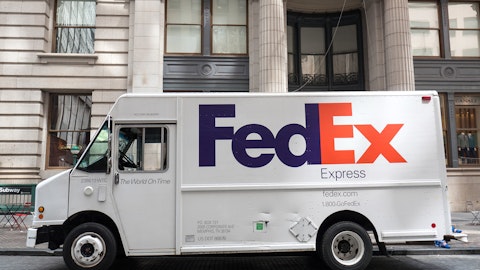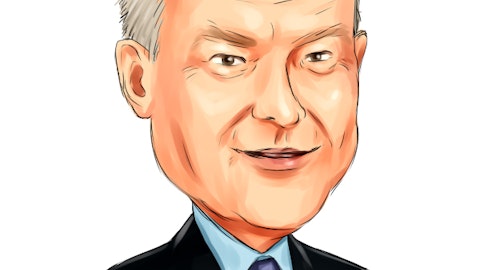Mike Zechmeister: And I would add on to that, that in the Global Forwarding business, the opportunity for tech enhancements is probably greater. The business is probably further behind truckload in the U.S., for sure, and LTL. And so there’s more complexity in Global Forwarding when you get languages, currencies, culture, customs that makes it a more challenging environment from a tech enhancement standpoint. But that being said, the tech enhancements on the Global Forwarding side have been great. They’ve done some really nice backhouse automation. They’ve got some customer-facing features that have improved services. And they’re excited about the tech for 2023. In fact, they’ve shown the tech to some customers. Nav 2.0 is something that customers are excited about. And it’s been a while, I mean, since our team internally has been excited about the upcoming year with respect to tech and Global Forwarding. Certainly is.
Scott Anderson: Yes, this is Scott. I’ll just add on just some perspective from the Global Forwarding team. And when you have basically a stress test that they’ve had and the amount of volume they moved and the way they did it over the last two years, they’re very open about areas where technology can help them improve. And to echo what Mike just said, we were with Mike earlier this week who heads up Global Forwarding, and I think he is excited about what’s coming but also excited to drive the change management internally that we’ll get the investment back on the tech investment for the return.
Bruce Chan: Great. Thanks for the color.
Operator: Thank you. The next question is coming from Jeff Kauffman of Vertical Research Partners. Please go ahead.
Jeff Kauffman: Thank you very much. I had a question for Arun. Arun, where — when you think of digitalization and digital transactions on the platform, how do you define what’s digital versus what’s not digital? And thinking about both the Forwarding and the NAST businesses separately, where are you in terms of percent of transactions that are — you consider digital today? And where do you want to be by the time we’re finished with this change?
Arun Rajan: Yes. I mean the way we think about digital versus non-digital, if there’s a manual touch, it’s generally not digital. So you take in-transit tracking as an example. And I think the way a digital-first company might approach that might be different than a broker has approached it for the past couple of decades. And historically, there have been several — lots of touches as it relates to in-transit tracking. And the way I think about it is the less we touch the load as it relates to in-transit tracking, the better it is in terms of both productivity of our internal people, obviously. And equally for our customers, it’s a better experience because you have less variability in service outcomes, and it’s a more standardized outcome for them.
So that’s kind of how we think about it across multiple processes in the life cycle of the load. So think about track and trace, think about document management, payments, appointments and so on. So it’s a matter of driving down the manual touches for each of those processes systematically over time, which drives greater productivity and better customer experience and carriers. That’s kind of how we think about it. Scott, go ahead.
Scott Anderson: Yes. I would just add sort of how I talk about it to the employees as sort of an incumbent leader in the space that is using technology to sort of modernize the business is through sort of some business examples, I come from a distribution background. So you look at a company like Grainger and how they’ve leveraged technology to really drive tasks but then unleash the expertise their employees have for their customers. That’s very similar to, I think, the opportunity we have here is really make our employees or logistics experts much more productive and then make technology tools that are sticky to the customer and that they really appreciate in terms of just making us easier to do business with. And I think Arun’s product team is absolutely on that track.
Arun Rajan: And maybe just to add some color to what Scott said. Reducing touches, for sure, along the lines of what I described, were equally amplifying the abilities of our people. An example might be someone in sales. How do we do targeted sales versus sort of the approach that you might have taken in the past? The ability to take behavioral data and give them insights to be more targeted in their efforts.
Jeff Kauffman: And then the second part of that question, please, Arun, where are you today in terms of — however you choose to think of it. I was thinking percentage of transactions that are digital. Where do you want to take that in two or three years? And where do you want to take that long term?
Arun Rajan: I think the lens to look at it is — these are all inputs, and the output that we’re looking for is effectively better productivity of our people as we measured by shipments per person per day and a better customer outcome or carrier outcome. In the case of customers, it’s better on time in full performance and greater customer satisfaction. So those are the output metrics we look at. And so as a goal for 2023, we have a productivity improvement expectation from these investments of 15% that we track quarterly. I think it’s better for us to look at it that way. And the input metrics might vary because we might see a greater opportunity for productivity in in-transit tracking versus appointments. And so we’d rather not go there on these calls and just focus on productivity and customer outcomes as the expectations from these investments.
Jeff Kauffman: Okay. Thank you very much.
Operator: The next question is coming from Chris Wetherbee of Citi. Please go ahead.
Chris Wetherbee: Thanks. Good afternoon. Scott, maybe a question here about Global Forwarding. So it sounds like this is something you think is key to the portfolio going forward. So I think it would be helpful to maybe give a bit of a perspective of where you think we are in sort of the normalization cycle. Obviously, the pandemic boosted rates to extraordinarily elevated levels, and as you noted in the release, were kind of back down to pre-pandemic levels in some of these end markets. So prior to 2020, this business was generating net revenues north of $500 million. It peaked out, obviously, a multiple of that. What is the right number for Global Forwarding as we start to go forward? I guess maybe in other words, how much share has been sort of captured there? What’s the cross-selling opportunity? Just if you could give us some perspective of how to think about it in the context of normalization, I think that would be great.
Scott Anderson: Yes. Great, Chris. I’ll make a few comments and then turn it over to Mike to dive into a little more granular detail. I would say my statement is Global Forwarding at Robinson today is a much stronger business than it was pre-pandemic. And I think part of what we owe to you is exactly that question is what is the run rate of this business on a more normalized rate. I’m super encouraged by Mike Short and his team and what we’re doing in the marketplace, knowing that we’re up against a backdrop of a tougher marketplace this year. But maybe Mike can give some specifics in terms of some numbers to help you with that question.
Mike Zechmeister: Yes. Chris, happy to do that for you. So after running operating income margins of over 50% in Global Forwarding in Q1 and Q2, obviously, we knew that wasn’t a sustainable level, and the market would come back to us at some point. The normalization, if you call it that, has surprised us a bit in terms of the speed and magnitude of the correction. And so I think in that process, we found ourselves with cost structure that didn’t match the business. And so we are in the process of kind of rightsizing that cost structure. During the pandemic in some of those periods, we were intentionally investing in our business. There was the ability to get the attention of customers to a greater extent. We were improving customer service.
We’re investing in technology. And the intent all along was to come out of the pandemic in a better place. And we feel like we’ve done that. But as Q4 demonstrates, when you look at the operating income margin, we’ve still got a ways to go in rightsizing our cost structure, and Mike and the team have been getting after that. Headcount is down and will be down further as we enter into the New Year. We do think that a 30% operating income margin for the long term is still the right number. And I mentioned the technology and how the technology can help improve the operating margin on a go-forward basis, but I’ll mention a few other things that I think are key to success in that Global Forwarding business, too, and things that the team is encouraged for in terms of continuing to gain market share as we go.
But another one I’d mention is operational uniformity. That’s really standardizing a lot of the work and activities that are done there. They have a good start on that, but there are still quite a bit more there that generates efficiency. And the good news is that as they come out of the pandemic here, the customer excellence scores are pretty solid. Team wants to make them better, but they’re in pretty good shape from that perspective. Continuing to build scale. So the pipeline for new customers has been solid. They’re looking at new verticals. They’re looking at new trade lanes. And building that scale will be important to help us leverage the investments that we’re putting in on that business to ensure that they’ve got a good return. I talked about their intentions and actions around managing expenses and headcount.
That did get out of line a little bit here in the back half as rates in ocean and air really came back quite dramatically. And then the last thing I’d mention would be talent acquisition. So there’s a lot of talent out in the marketplace. The team has done a pretty good job of bringing in folks that can help us extend into new verticals and extend into new trade lanes and geographies. And so continuation of that also gives us confidence that they can continue to grow market share going forward. And that will be the key to success and the key to getting that margin to 30% long term.
Chris Wetherbee: Okay. So the idea is relative to that pre pandemic era. Margins maybe could be double what they were, so there’s the ability to absorb some downside shock here or normalization over the course of this year and next year on the net revenue line. I guess that’s the way to kind of triangulate to the way you think about profitability of the business.
Mike Zechmeister: I think that’s fair.
Operator: The next question is coming from Jordan Alliger of Goldman Sachs. Please go ahead.
Jordan Alliger: I was wondering if you could talk a little bit to where you think we are from a spot market perspective for truckload pricing. And sort of based on where you think maybe that bottoming occurs, how are we in terms of contract timing on your non-renegotiated contracts to this point? Thanks.
Mike Zechmeister: Yes. Jordan, let me take that. So first of all, the demand has really pulled back here. That’s pretty clear. And as a result, the spot market has really dried up. There’s not a ton of opportunity there. In the prepared comments, we talked about we’re sitting at a contract business that the commitments from the customers to be able to deliver the volumes that were inside of those contract agreements are being pressured because of the overall demand. So the business right now, we were 65-35 contract spot. The spot opportunities are not there to a great extent. And so we would expect that, that eventually flattens out here as we go through the year. I’m not sure if you follow the projections that we have in the marketplace around pricing, but we’re anticipating a 16% year-over-year decline in truckload spot cost per mile in 2023, most of that coming early in 2023.
And then the contract pricing generally follows where the spot market is on a lag basis. And so inside the contract business, maybe I’ll take you back to the beginning of 2022. And so as we were entering into new contract business and bidding on contracts that were available, we were looking at the potential in the back half of ’22 with COVID shutdowns, the holiday season, Chinese New Year coming that prices would hold up more than they did. As things played out, there really wasn’t a key season. The demand was soft. The prices came down. And so as we were bidding on contracts in Q1 and Q2, we weren’t as successful on a win percentage as we probably would have liked to have been. And certainly, we would have been better had we known the drop-off that was coming.
So then you kind of get us to real time here, Q4 and into Q1. We’re out there in the market on these contracts. We’re bidding competitively, and we’re feeling pretty good about the win rates. But the demand and the volume there from the customer just isn’t strong. So even with our higher win rate from a bid standpoint, the volumes that are materializing are still challenged. We talked about kind of in Q4, the decline in truckload volume that we had seen, and obviously delivered a minus 4% in the quarter. It is not our intention to have negative numbers on our truckload volume. We certainly expect to grow, but it was a soft market. And the good news, I think, for us is as we come into the New Year, we’ve seen a better performance on the truckload volume side into January here.
When you talk about the contracts themselves and what’s coming, one of the things that I think over the past few years during the pandemic that we observed was that what was largely a 12-month bid contract had transitioned to contracts that were of lesser duration. And what I can tell you in Q4 is that, that continued in that about half — roughly half of the contracts that we bid on were 12 months, and the other half were something less than that. So even as the market has come down, that mix has remained in the contracts that are less than 12-month duration. So I covered a few of the parts of your question. Anything that I missed?





